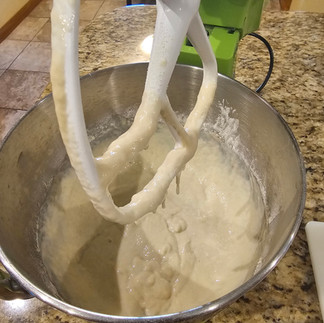Back to School with the Castle Test Kitchen: Some Things Are Better Left as Memories...
- kellison71
- Aug 24
- 5 min read
It’s back-to-school time in the Castle Test Kitchen, and all this talk of pencils and backpacks has us feeling nostalgic—for our favorite school cafeteria foods. That’s why today’s feature is the (in)famous rectangle cheese pizza of 1970s/1980s school lunch fame. Walk the halls of one Castle Test Kitchen staffer’s elementary days at K.C. Ling Elementary School in Hemlock and enjoy a slice of local history—and pizza!


The Kenneth C. Ling Elementary School at 835 N. Pine Street in Hemlock opened its doors in November of 1975 after the small, rural district passed a $3.42 million bond just two years earlier. With the addition of a brand-new elementary school building and a new general services building along Hemlock Road, additions and improvements were also made to the middle school, high school, and Hemlock Elementary buildings.
Originally housing third through fifth grades, the K.C. Ling building boasted a circular arrangement of 24 classrooms and six activity rooms surrounding a central audiovisual and library area. The open-concept building was state-of-the-art in 1975 with the flexibility of temporary walls defining the spaces as needed. The north end of the building held the offices and multipurpose areas in a tidy, single-level spoke from the circular wheel of education. The design came from Douglas C. Morris Architect & Associates of Bay City.
Named after Kenneth C. Ling, the building was a testament to the growing student population of the district in the late 1970s. Ling, who had served as the town doctor for decades and a dedicated member of the school board for 14 years had passed away just a few years earlier. In the 1970s, Richland Township was quickly, though quietly, expanding with the Hemlock Semiconductor Corporation opening nearby just a decade before and the sprawl of Saginaw Township into the Shields area approaching the countryside. In 1980, the Meijer on Gratiot Road in Shields would open to accommodate the new neighborhoods to the West of the township and city.
Slides from the K.C. Ling Dedication open house in 1975
Today, the Hemlock Public School District is again expanding and improving as is Hemlock Semiconductor—bringing more families to the area. As a result, K.C. Ling Elementary still stands—with a new gymnasium affixed to the south side of the circle. Those open concept rooms have long since been walled over as student safety and focus became a greater need in the 2000s, but the middle section continues to serve as a library today. The building currently houses grades 1-4.
This CTK staffer longs for the days when the way to the office was defined by a crepe paper apple dangling from the drop ceiling (and the exit to the buses a banana)—but we’ll always have our memories and rectangle pizza.

The Recipe: Pizza with Cheese Topping (a.k.a. Rectangle Cheese Pizza)

By the 1970s, as school districts became more streamlined after consolidation and expansion, school lunch programs also sought to become more efficient and economical. As a result, the United States Department of Agriculture Food and Nutrition Service put out a recipe booklet to assist the weary lunch ladies with the task of providing a warm, nutritious, yet comforting, meal for hundreds of students each day, “Quantity Recipes for School Food Service.”
Every student had their favorite “hot lunch” meal, but a quick survey of the Hemlock community Facebook Page suggests that most Hemlockians have fond memories of the rectangle pizza—which came in cheese or beef. Today, we’ll stick with the classic…

Ingredients (for 100 servings):
Pizza dough in pans…5 full sheet pans
Dehydrated onions…1 Cup, 2 Tablespoons
Garlic powder…1 Tablespoon, 1.5 tsp.
Black pepper…2 tsp.
Tomato paste…1/2 of a No. 10 can
Water…3.5 quarts
Flaked basil…1/4 Cup, 2 Tablespoons
Flaked oregano…1/4 Cup, 2 Tablespoons
Flakes marjoram…1/4 Cup, 1 Tablespoon
Flaked thyme…1 Tablespoon
Mozzarella Cheese, shredded…3 ¼ gallon

CTK Interpretation (9 servings):
Pourable Pizza dough (from “Quantity Recipes…”) in one half sheet pan
1 tablespoon plus 2 teaspoons minced dried onion
1/2 teaspoon garlic powder
1/4 teaspoon black pepper
2 teaspoons dried basil
2 teaspoons dried oregano
1 1/2 teaspoons dried marjoram
1/2 teaspoon dried thyme
1/2 cup plus 2 tablespoons tomato paste
1 1/3 cups water
5 1/4 cups shredded mozzarella
Pourable Pizza Dough Ingredients:
2 1/2 tsp active dry yeast
1 2/3 cup warm water (110°F)
2 1/2 cups all-purpose or bread flour
3/4 cup instant nonfat dry milk
2 tablespoons sugar
1/4 tsp salt
1 1/2 teaspoons vegetable oil, plus more for greasing the pan
1 1/2 tablespoons cornmeal
Directions:
For the crust: Preheat the oven to 475°F. Stir the yeast into the warm water until it’s mostly dissolved and let it sit for 5 minutes to become foamy.
Combine the flour, dry milk, sugar, and salt in the bowl of a stand mixer. Mix with the paddle attachment on low until combined. After the dry ingredients have mixed, add the yeast mixture and the vegetable oil and mix on medium speed for 10 minutes.
While the batter mixes, coat a half sheet pan with oil, then sprinkle it evenly with the cornmeal.
Once the batter is ready, spread it evenly into the prepared pan. If you’re having trouble getting it to spread, let it sit for a few minutes, then try again. This allows the batter to relax and become more spreadable.

Bake for 10 minutes in a regular oven. It should only be partially baked at this point, and it’s time for toppings.
For the sauce: In a saucepan, stir together the seasonings with the tomato paste and water. Bring to a simmer, then continue to simmer for about 10 minutes.
To assemble: Keep the oven temperature at 475°F.
Sprinkle 1 1/2 cups of the cheese evenly over the parbaked pizza crust. Spread the sauce evenly over the cheese. The sauce and cheese will likely end up mixing together, and that’s okay.* The most important part is to make sure the sauce is spread evenly over the whole pizza to the edge of the pan.
Sprinkle the remaining cheese over the pizza, all the way to the edges. Bake for 10 to 15 minutes, or until it browns on top.
Slice the pizza into 8-9 even rectangles.**

We suggest you serve it with everyone’s favorite, pineapple tidbits, and of course, chocolate milk. We also threw in some generic salad mix, as was the standard in the 1980s lunchroom.
*We found that the cheese, when sprinkled first, melted onto the crust a bit and allowed the sauce to be spread over the top. This may be a measure to keep the two layers of cheese melded together when eating.
**While it should be 9 rectangles, it’s been a long time since we had math class, and we miscut it into a more generous 8-rectangle assortment.
Special Thanks to the Tasting History website, who also tested this recipe and had some valuable insights.
CTK Tasting Notes:
--We assembled a group of expert taste testers from our K.C. Ling days to give their opinion on the validity of this pizza recipe. The results:
--While the smell seemed right as it was cooking, the taste was a little off and there was never this much cheese.
--It wasn’t good then, and it isn’t good 40 years later.
--There is no way they would have shredded actual cheese (though the CTK agrees that the end product “sheet of cheese” on top is true to the past).
--The spices in the sauce seemed off, as taste testers didn’t remember it being that dark in color. The CTK notes that lunch ladies may have simply used a jarred sauce.
--The crust seemed accurate, but should have cooked longer in the pre-bake to be firmer.
--We wondered how long these pizzas stayed in a warmer ahead of food service—this may have impacted the final result as well. Alas, this detail is lost to history.










































